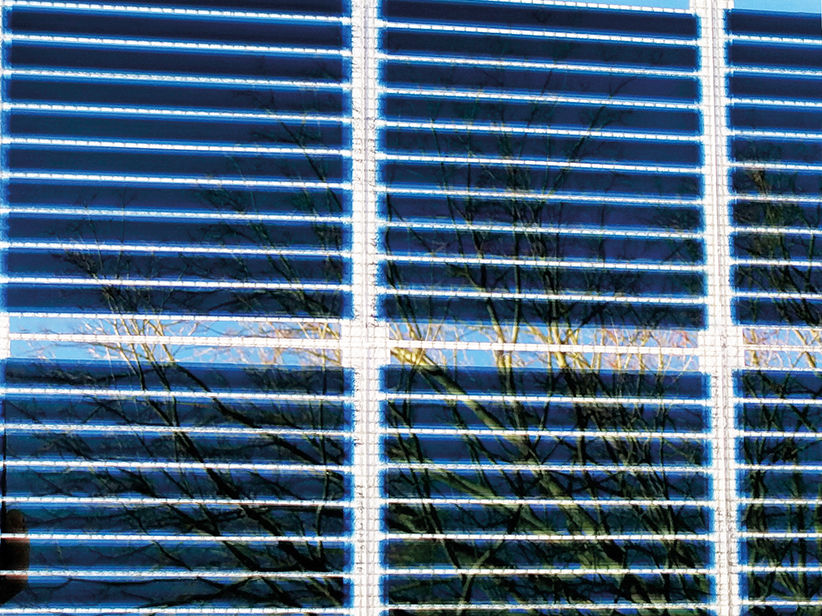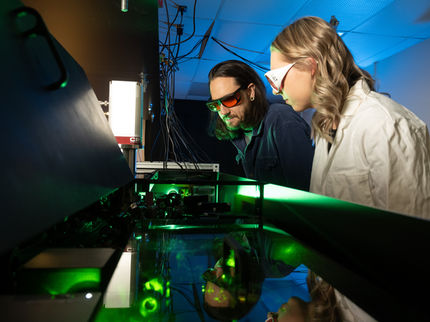Imagine a jacket that produces enough electricity to charge your mobile phone
Photovoltaics: easy implementation thanks to modern printing techniques
Renewable Energy has become an important topic in today’s society. Modern printing solutions promise the easy and cost efficient production of photovoltaics elements, even beyond architectural uses.

The printed stripes make all the difference. By series connection, each square of ten stripes is capable of producing a voltage of about 8 Volt.
© Foto Fraunhofer IAP
At the international exhibition and conference for the printed electronics industry LOPEC 2018 the Fraunhofer Institute for Applied Polymer Research IAP displays its competences, especially regarding inkjet-printing techniques. With these solutions, façade elements for the production of solar energy can be printed. Due to the printing technology used, these elements can be produced on a larger scale with reduced costs compared to conventional production methods. Further applications can be found in optoelectronics and medicine. The process of printing is also applicable within the textile industry. Alongside a façade element the researchers display a jacket with photovoltaic elements which produces enough energy to charge a mobile phone and operate hand warming pads. The jacket even stores the energy. Currently the IAP-researchers are developing a solar powered LED-bicycle jacket together with industry partners.
The institute has its own pilot plant for printed electronics on which the displayed elements were produced.
“On our pilot plant we develop printing solutions in a very industry-oriented way. Together with our clients we then implement these solutions into their large scale plants based on the expertise we gather through our pilot plant. We improve our printing methods constantly and individually adapt them to our customers’ needs”, Dr. Armin Wedel, head of the research division Functional Polymer Systems at the Fraunhofer IAP, explains.
For small scale surfaces the scientists are working on implementing a novel drop-on demand system: esjet-printing (electro static printing). This technology allows the use of a wider range of inks, especially essential for printing very fine structures. Widening the range of possible inks regarding their viscosity is a big step. Inkjet-printing sets limits to the used ink’s viscosity. With esjet-printing, fine metal grids with high transmission rates can be printed and thus replace conventional transparent ITO-electrodes in photovoltaics components.
The Fraunhofer IAP and the OLED Technology Alliance, GOTA
Fraunhofer-researchers also present first customer projects resulting from the GOTA alliance. The Fraunhofer IAP develops processes and materials for future OLED production facilities in close cooperation with the plant engineering companies MBraun Inertgas-Systeme GmbH in Munich, Notion GmbH in Schwetzingen and ARDENNE GmbH in Dresden. The four partners have formed the OLED Technology Alliance GOTA in order to offer the market turnkey OLED production facilities.
Most read news
Other news from the department science

Get the chemical industry in your inbox
By submitting this form you agree that LUMITOS AG will send you the newsletter(s) selected above by email. Your data will not be passed on to third parties. Your data will be stored and processed in accordance with our data protection regulations. LUMITOS may contact you by email for the purpose of advertising or market and opinion surveys. You can revoke your consent at any time without giving reasons to LUMITOS AG, Ernst-Augustin-Str. 2, 12489 Berlin, Germany or by e-mail at revoke@lumitos.com with effect for the future. In addition, each email contains a link to unsubscribe from the corresponding newsletter.


























































